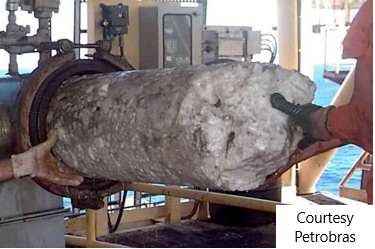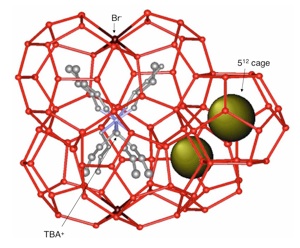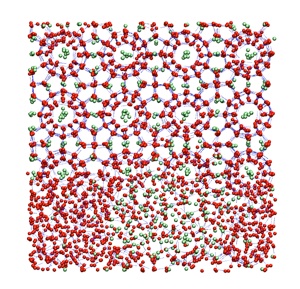Research
Oil and gas flowlines provide abundant reactants and the necessary pressure and temperature conditions for hydrate stability. In 1934, Hammerschmidt [1] showed that hydrates were causing blockages in natural gas transmission lines. Since that time, researchers have been developing models, such as CSMGem [2], to predict the necessary thermodynamic conditions for hydrate stability. Prediction of the hydrate stability conditions using such models is now possible within experimentally measurable accuracy.

Another important problem has been the prediction of how long it would take for a hydrate plug to dissociate once it had formed. A decade of research has allowed the CSMPlug program to make an order-of-magnitude estimate of the dissociation time under three different conditions: one-sided depressurization, two-sided depressurization, and electrical heating [3].
Traditionally hydrate blockages have been prevented by the addition of large quantities of thermodynamic inhibition chemicals such as methanol or mono-ethylene glycol to the flowline. These chemicals lower the temperature required for hydrate formation. Recently, the industrial paradigm has been shifting from this time-independent approach of hydrate avoidance towards time-dependent hydrate management.
Key to this paradigm shift has been the development and industrial implementation of Low Dosage Hydrate Inhibitors (LDHIs) [4], such as Kinetic Hydrate Inhibitors (KHIs) and Anti-Agglomerants (AAs).
Time-dependent phenomena have long been a focus of research at the Center for Hydrate Research. Since 2003, our goal has been to understand the mechanisms for hydrate formation in oil flowlines. To this end, a hydrate kinetics model called CSMHyK has been developed, integrated into the OLGA® multiphase simulator, and tested against three different industrial scale flowloops [5]. The model currently uses an empirical equation for hydrate growth with fitting parameters regressed based on flowloop data for crude oil systems.
The research in the Center continues to further refine the CSMHyK model for oil and gas flowlines, such as:
- Experiments in a high pressure cell fitted with FBRM and PVM probes to give new insight into the way that entrained water droplets convert to hydrate agglomerates.
- High pressure DSC measurements to probe the effect of hydrates on water-in-oil and oil-in-water emulsions behavior and emulsion stability.
- Development of growth models with a more fundamental basis to identify the most critical unknown physical parameters.
- High pressure rheometry to understand how hydrate particles affect the flow properties of crude oils.
- Experiments and simulations on particle flow to understand the jamming behavior of hydrate particles.
Footnotes
1. E. G. Hammerschmidt, “Formation of Gas Hydrates in Natural Gas Transmission Lines,” Industrial Engineering & Chemistry, 26:851 (1934).
2. A. L. Ballard, A Non-Ideal Hydrate Solid Solution Model for a Multi-Phase Equilibria Program, Ph.D. Thesis, Colorado School of Mines (2002).
3. S. R. Davies, M. S. Selim, E. D. Sloan, P. Bollavaram, D. J. Peters, “Hydrate Plug Dissociation,” AIChE Journal, 52:4016 (2006).
4. M. A. Kelland, “History of the Development of Low Dosage Hydrate Inhibitors,” Energy & Fuels, 20:825 (2006).
5. D. J. Turner, J. Boxall, S. Yang, D. M. Kleehammer, C. A. Koh, K. T. Miller, E. D. Sloan, “Development of a Hydrate Kinetic Model and its Incorporation into the OLGA2000® Transient Multiphase Flow Simulator,” Proceedings of the 5th International Conference on Gas Hydrates, Paper No. 4018, pp1231-1240, Trondheim, Norway (2005).
6. E. D. Sloan and C. A. Koh, “Clathrate Hydrates of Natural Gases”, 3rd ed., CRC Press (2007)

Ocean hydrates at the Barkley Canyon off the coast from Vancouver, Canada.
The hydrate community is entering a time of exciting discovery in the area of Hydrates in Nature, and Center for Hydrate Research is no exception. With the prospect of high natural gas prices, the Center is conducting research aimed at assessing the risks and benefits in the production of hydrocarbons from gas hydrates in permafrost zones and near-seafloor offshore hydrate deposits.
Work in this area includes collaboration with Lawrence Berkeley National Laboratory (LBNL) to refine hydrate production models. As the world tries to understand and stem the possible contribution of hydrates to global warming, the Center is also collaborating with the Monterey Bay Aquarium Research Institute (MBARI) to understand the behavior of protruding hydrate mounds on the seafloor and their possible contribution to the atmospheric methane budget. Furthermore, as conventional oil and gas deposits are sometimes found underneath hydrates, understanding the geomechanics of these formations is vital for ensuring the safety of operations on and in hydrate-bearing zones. The research in the Center aims to ensure that human activity does not compromise the safety of operations near hydrate-bearing zones. From production optimization to global warming issues to safety assurance, the Center is conducting diverse and exciting research in the field of Hydrates in Nature.

TBAB semi-clathrate structure.

Snapshot of molecular simulation of hydrate nucleation.
The Hydrates in Science community at the Center for Hydrate Research is continuing its strong tradition of investigating the fundamentals of hydrate phenomena with the goal of applying the results to practical aims such as hydrogen storage, kinetic inhibition, and gas recovery.
The Center uses nuclear magnetic resonance (NMR) and Raman spectroscopy, X-Ray diffraction, and molecular simulations to study the mechanism of hydrate formation and dissociation and the structure and guest occupancy of the hydrate cages.
The Colorado School of Mines recently acquired a 23 Teraflops computer cluster, which will enable our ongoing molecular simulations investigations of hydrate nucleation. Elucidating the process of hydrate nucleation will provide much deeper understanding on homogeneous and heterogeneous nucleation processes, a long-standing problem in hydrate science.
As the Center pursues the basic science of hydrate phenomena, we will use the acquire fundamental knowledge of scientific research to thrive in the applications, which include improving the state of hydrogen storage, flow assurance, and oil and gas recovery.